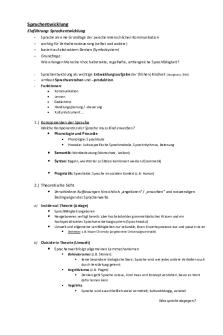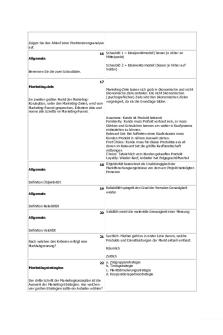Japan: Metabolismus - Vorlesungsnotizen 5 PDF

| Title | Japan: Metabolismus - Vorlesungsnotizen 5 |
|---|---|
| Author | Yunshu Huang |
| Course | Architekturtheorie II: Architekturtheoretische Grundbegriffe (Architektur Master) |
| Institution | Technische Universität Berlin |
| Pages | 2 |
| File Size | 44.2 KB |
| File Type | |
| Total Downloads | 83 |
| Total Views | 128 |
Summary
architekturtheorie...
Description
Japan: Metabolismus Kurokawa, Helix City Isozaki, Future City Kurokawa, Nagakin Tower Kenzo Tange, Plan für die Überbauung der Tokyo Bay, 1. Jan. 1961 Kenzo Tange, Tsukiji Plan 1960 Kikutake, Ocean City, 1960 Der Metabolismus zeichnet sich dadurch aus, 1. Megastrukturen auf technizistischer Grundlage; 2. Massenfertigung und industrielle Produktionsformen wie Elementierung und Standardisierung; 3. Flexibilität und die Möglichkeit zu dynamischem Wandel, Austausch der einzelnen Elemente und dynamische Erweiterung der Stadtstruktur; 4. starke Bildregie mit dem Ziel eines Nationalstils; 5. in der Luft und auf dem Wasser – neuer Lebensraum – nach den Atombomben und der Verseuchung der Lebenswelt Kawazoe, der intellektuelle Kopf der Gruppe der Metabolisten, beschrieb den Metabolismus folgendermaßen: “Changeability and flexibility were the key elements that the Metabolist Group seized upon and explored. Metabolism, as we know it, is the biological process by which life is maintained through the continuous cycle of producing and destroying protoplasm. To the Japanese architects who adopted the name, it meant creating a dynamic environment that could live and grow by discarding its outdated parts and regenerating newer, more viable elements.” Kawazoe, Noboru: „At the root of this thinking was the idea that man, architecture and the city, rather than being opposed to nature, are a part of nature, and that the universal is
principle of life. What, then, is the fundamental principle of life? Probably it is regeneration, the exchange of the old with the new. Is there a suitable word expressing this concept? Kikutake looked in the dictionary and picked out the word „metabolism“. The word contained the suffi x „ism“ and sounded rather like an assertion of principle. We decided to adopt it.“ (AUS: The Thirty Years of Metabolists, In: Thesis 6/1998, S. 147)
Metabolismus als Zukunfts- und Verfallsform Arata Isozaki, City in the Air 1962 Arata Isozaki, Future City, Incubation Process, 1962 Arata Isozaki, Tuskuba Central Building (1979-83) Konkretisierung einer Idee Kisho Kurokawa, Weekend House, Karuizawa Kisho Kurokawa, Toshiba IHI Pavillon, Osaka Expo, 1970
Kisho Kurokawa, Takara Beautilion Kenzo Tange, Yamanashi Press and Broadcasting Center Kofu 1964/67 Kenzo Tange, Shizuioka Press and Broadcasting Center, Tokio 1967 Yona Friedman, La Ville spatiale, 1960 Archigram/Peter Cook: Plug-In-City 1964 Kiyonori Kikutake, Aquapolis, Ocean Expo 1975 Okinawa Arata Isozaki, Joint Core System, Shinjuku 1960 Koyonori Kikutake, Tokoen Hotel (1963-64) Kiyonori Kikutake, Skyhouse 1959
Ist der Metabolismus gescheitert Kiyonori Kikutake, Tokyo Edo Museum 1993 Kiyonori Kikutake, Sofitel Hotel, Tokyo, 1993 Arata Isozaki, Florenz Bahnhof (Wettbewerb) Arata Isozaki, Doha National Library 2003, Projekt Kengo Kuma, Aore, Rathaus in Nagaoka, 2011 Junya Ishigami, KAIT Workshop, Kanagawa Institute of Technology Sou Fujimoto, Jardins des Tuileries, Installation Sou Fujimoto, Final Wooden House, Kumamoto 2008 Sou Fujimoto, House NA...
Similar Free PDFs

Diagnostik 05 - Vorlesungsnotizen 5
- 12 Pages

C - Japan
- 4 Pages

Samenvatting Japan
- 52 Pages

Samenvatting Japan
- 11 Pages
Popular Institutions
- Tinajero National High School - Annex
- Politeknik Caltex Riau
- Yokohama City University
- SGT University
- University of Al-Qadisiyah
- Divine Word College of Vigan
- Techniek College Rotterdam
- Universidade de Santiago
- Universiti Teknologi MARA Cawangan Johor Kampus Pasir Gudang
- Poltekkes Kemenkes Yogyakarta
- Baguio City National High School
- Colegio san marcos
- preparatoria uno
- Centro de Bachillerato Tecnológico Industrial y de Servicios No. 107
- Dalian Maritime University
- Quang Trung Secondary School
- Colegio Tecnológico en Informática
- Corporación Regional de Educación Superior
- Grupo CEDVA
- Dar Al Uloom University
- Centro de Estudios Preuniversitarios de la Universidad Nacional de Ingeniería
- 上智大学
- Aakash International School, Nuna Majara
- San Felipe Neri Catholic School
- Kang Chiao International School - New Taipei City
- Misamis Occidental National High School
- Institución Educativa Escuela Normal Juan Ladrilleros
- Kolehiyo ng Pantukan
- Batanes State College
- Instituto Continental
- Sekolah Menengah Kejuruan Kesehatan Kaltara (Tarakan)
- Colegio de La Inmaculada Concepcion - Cebu











